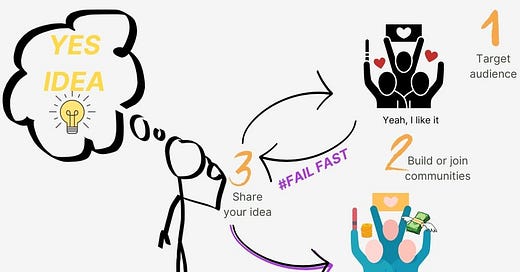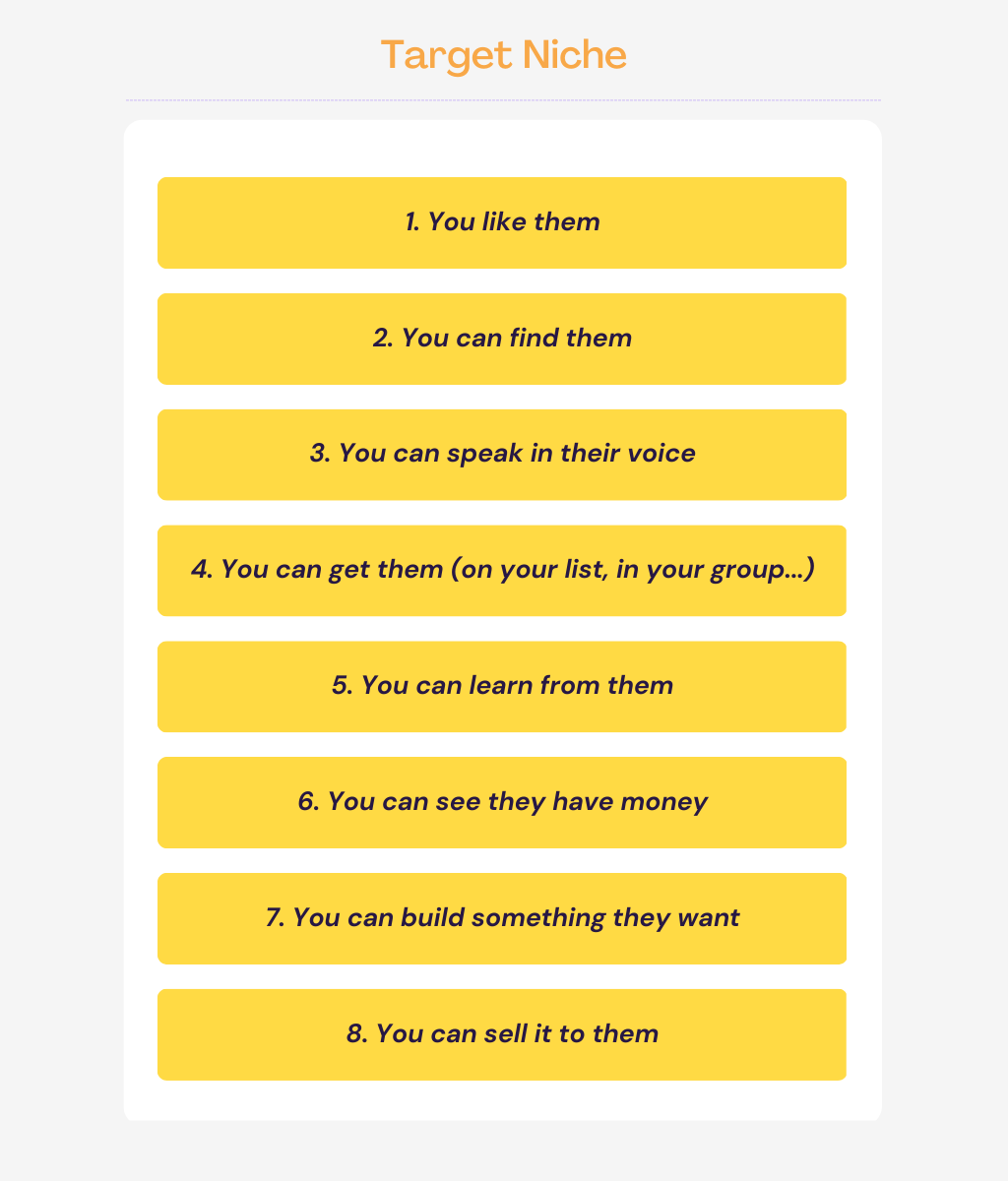How to validate SaaS Ideas
SaaS Treasure Hunt: The Ultimate Guide to Validating your Killer Idea!
Welcome to the 112 new subscribers joined this week 🥳.
You can connect with us on LinkedIn, where we share our insights on business, SaaS products with our community.
💡 Recap: where to find ideas
In the previous post, we talked about Step 1 & 2 of getting to the only “good” idea.
So, after generating multiple ideas (Step 1) and filtering them (Step 2), you should probably have a shortlist of 4 to 5 ideas by now.
Start Step 3 by picking an idea to validate. If you fail, go back to Step 2.
If none of your shortlist’s ideas get validated, go back to Step 1.
Today, we dig deep into Step 3.
🚀 How to validate the only good Idea ?
So you have an idea, this is good ! but not GREAT !
Why? Because you need an audience
Without an audience, a business cannot exist.
Without an audience, you have no customers to serve or to provide value to.
Get the audience and learn how to talk to customers/ prospects to validate the “good” idea.
So here is the way to validate your idea when you don’t have an audience:
Step 1: Work out who your target customer is.
Step 2: Build an audience (OR join a community) of your target customers.
Step 3: Share your Idea with the audience and/or community.
—> Your desired Response: “Shut up and take my money !”
—> Undesired Response: “Yeah, I like it”.
If you don't get the desired response, iterate the idea and loop back to step 3.
If you never get the desired response, #FailFast and go back to Step 2 of where to find ideas but with the status “Yes Audience / No Idea”
🧲 How to get the audience?
Now, there are mainly two ways to deal with this. Either you grow an audience organically through different channels, or you pay to reach them.
However, for genuine success, the following statements should be true for any niche you pick:
It is not always easy to choose a market in which you are currently involved, so you’ll need to understand enough about your market to be able to make all of the above things true - and quickly.
📈 Get your audience organically :
You can organically find existing audiences or create new ones through the following channels: Email list, Facebook group, slack group, blog, YouTube, and social media.
Step-by-Step Instructions to get you started with each channel
How to Get Your First 100 Email Subscribers (Neil Patel)
How To Grow Your Email List Fast (Ash Read)
How To Create, Setup, & Grow a Highly Engaged Community With Slack (Hamster Pad)
How To Set Up A Community With Slack (Caroline Zook)
How to Launch Your Brand New Blog From Scratch, In 14 Steps (David Risley)
How to Start a Blog in 2020 (Jon Morrow)
How to Start (And Grow) a YouTube Channel in 2020 (Brian Dean)
How to grow a social media following in 2020 (Connor DeLaney)
Tools that helps you find audiences or generate leads:
Gummy Search: Research tool that helps find your audience on Reddit.
Sparktoro: An audience research tool that helps you discover people's sources of influence.
Facebook Group Leads: Add FB Group members to a spreadsheet.
💸 Get your audience paid :
In this article, Jakob makes a good point about time and money in validation.
To put it in simple words, if you have 4 to 5 ideas, how much time would it cost you to validate each idea? 3 to 6 months at least...
If you don’t have $400 per month for Google Ads or paper clip ads, then you don’t have much of a choice, and you have to wait for as much to achieve validation...
If you do have the budget, then put that money into ads and validate 3 to 4 ideas at the same time in a single month.
If you choose to go with ads spending, there are a couple of metrics you should track and understand first.
Going paid metrics:
I tried Twitter ads for 2 days, I paid 50 euro and got 21k impressions and 52 clicks. Here are our metrics :
CPA / CPL = 50/2 which means 25 euro per customer.
CPC = 50/52 which means 0.96 euro per click.
CPM = 50/21 which means 2.38 euro.
CTR = 52/21k which means 0.24% .
I can tell from my metrics that my ad wasn't attention grabbing. I didn't have a CTA (Call-To-Action) and the design wasn't very appealing.
Key Notes:
Every brand needs some brand awareness. You need to start with a good CPM, to achieve visibility and then niche it down.
CPA or CPL depends on your website more than the ad itself.
Know where and when to track the right metrics and improve them per use case.
Here is another use case for Reddit Ads.
📣 How to talk with customers:
The key to evaluating the validity of a business idea or a product is to learn how to ask the right questions and prevent leading customers to provide a favorable response. Instead, you get honest feedback on whether the product or concept solves a real problem that the client is experiencing.
Here are some do’s and don’ts based on The Mom Test approach:
✔️ Do’s
Avoid yes/no questions.
Pose open-ended questions and invite customers to share their thoughts and experiences.
Pay attention to the customer's problems.
Actively listen and take notes.
Ask follow-up questions to expand on their responses.
Use customer feedback to refine your idea.
❌ Don’ts
Don’t lead customers to particular answers.
Don’t try to sell or convince them of the idea's worth.
Don’t use technical terms and buzzwords. That can be confusing!
Don't be defensive if you face criticism, and ask questions to understand the customer's point of view.
If you want to Deep-dive into this topic, check How to talk to users.
☑️ How much validation Is enough validation?
I asked several indie hackers this exact same question; The majority told me that getting some people to sign-up for their websites was their sign of validation. Another few said that they tried to get some pre-sales. But what do “few” and “some” exactly mean?
I personally think that just having someone sign up on your website or landing page, it's like someone agreeing to go on a date with you - it doesn't necessarily mean that they're interested in a long-term relationship with your product. But maybe you’re just looking for some company… who knows!
This is why you should set up a validation goal first.
A good validation goal is:
Specific
Measurable
Has a timeframe
is not a bullshit metric
A bad validation is:
Have some visitors to your website
Build a large audience for a specific niche
Win awards with your idea
Have media coverage
These validation thoughts are not specific nor measurable, and definitely without a timeframe!
Some better examples of validation
Have X pre-orders by dd.mm.yyyy
Hit X subscribers by dd.mm.yyyy
Conduct X customer development interviews by dd.mm.yyyy
Get X% conversion out of the Z visitors
According to Rob walling: e.g. reach 10k visits in one single month and when 5% to 10% of your website visitors opt-in, you have your first signal of validation.
Note: Get out there and reach out to your potential customers and people who signed up. Ask them about their specific needs and their willingness to pay. Your idea is only validated when you reach your validation goal AND have some real commitments.
Here are some additional resources to deep dive:
The Complete Guide: How to Validate SaaS Ideas - (Kalo Yankulov)
How to validate SaaS idea in 2022 - (Denis Shatalin)
Validate your SaaS idea FAST - (Rob Walling)
Bonus:
Starter kit for validation:
A website for signups is fundamental for validation, this is how you can do it.
Your landing page should be designed to get people curious by explaining the benefits of solving the problem you created in your hypothesis. Don’t spend a lot of time on your landing page. Deep dive here.
Form: Once people sign up, you can use either Typeform OR a free version like Tally to get some feedback.
Ask people only a few questions ... Keep it short, opt for a maximum of 4 questions.
I prefer Typeform because its more professional and smoothly guides the user through the whole process.
Analytics: Google Analytics and Mixpanel (free tier) to measure traffic.
Additional validation tools:
In case you're curious, here are some validation tools I discovered along the road.
AreYouInterested: A free platform that helps you quickly validate, and discuss business ideas.
UserTesting: Instead of interviewing users, this tool records user reactions to your product.
PingPong: A tool that schedules calls with people who will check out your product.
📑 Conclusion
If you failed to validate your idea, NOT a problem! Be thankful that you will not be wasting time and money on something that no one wants. Just like we did.
But let’s say you were successful, you found an idea and you validated it. People are not only interested in your idea, but they are also willing to pay for it!
What to do next? Well, it’s simple ... it’s focus time! Your only environment of work is the prospects that are willing to pay and their problem. Only focus on how to make their life easier, and reduce their risk. Help them make money and you will be the winner.
Ask me questions! Don’t be shy, I am willing to answer and chat, maybe grab some coffee if you are around. Just reply to this email.






